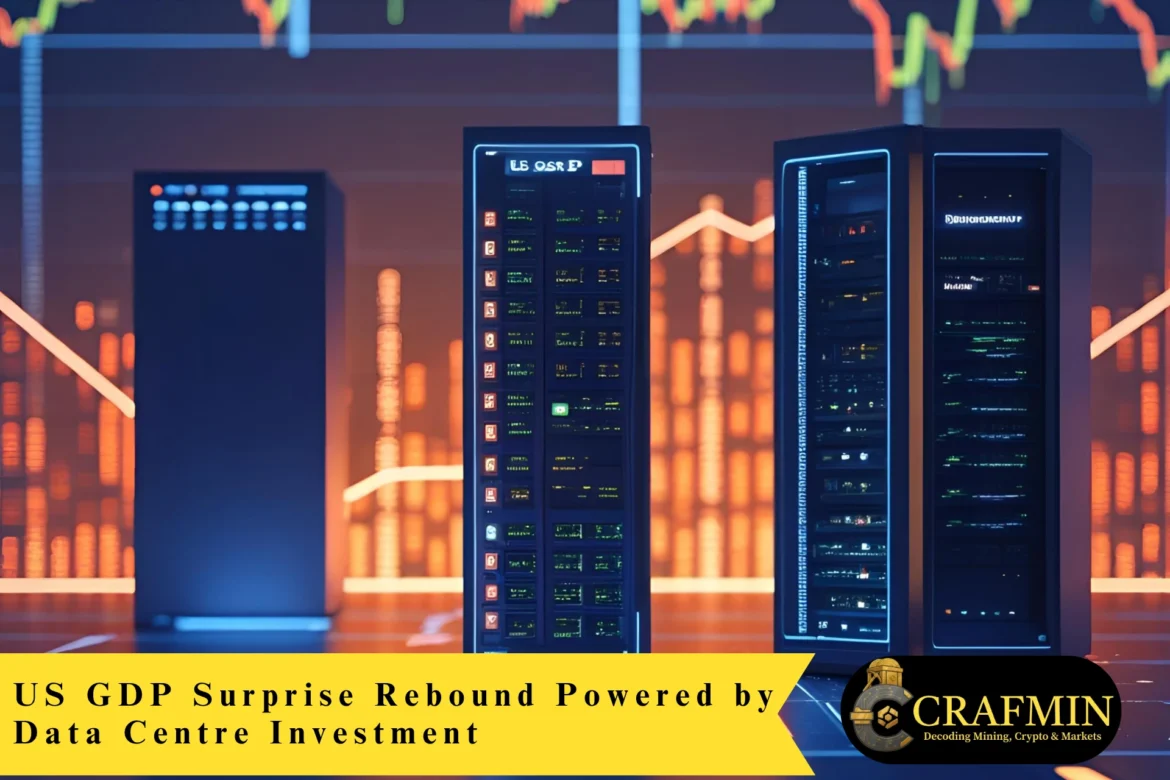America’s economy , us gdp has shown better-than-anticipated in the fourth quarter, and the surprise is originating from beyond typical sectors. There is a surprise driver: data centre infrastructure.
With the digital revolution picking up pace, power-hungry, always-on data centers are needed. The data center boom is sweeping across industries like construction, chip-making, and energy, and creating a huge GDP boom.
US imports of the large-scale computers typically used in data centers have hit new record highs, up 220% over this time last year—tariff front-running and the AI buildout are causing a historically unprecedented surge in demand pic.twitter.com/gtwqWGg6Oe
— Joey Politano ️ (@JosephPolitano) July 20, 2025
Economic Resilience in the Face of Recession Fears
Until recently, most analysts had worried that the U.S. economy was on the brink of recession. New evidence, though, suggests that infrastructure tech spending has been a key counter-cyclical force, injecting vitality into the economy when it needed it most.
At the heart of this boom is building high-density data centers across the country. They are not warehouses, they are infrastructure underpinnings of cloud computing, artificial intelligence, financial markets, and even international communications.
It is not an easy task to build the data centre. The centres require huge chunks of land, sophisticated planning, tonnes of raw material, and uninterrupted power supply. It is larger in terms of quantity for qualified people, electricians, engineers, and construction workers, and factory material like steel, copper, and fiber optic.
The chip industry is thriving as well. With new data centers requiring next-generation chips to manage workloads, chip makers see new demand and manufacturing increases to meet orders. Utilities are also ramping spending, seeking to displace grid infrastructure as stability and availability increase for these power-hungry complexes.
It’s a domino chain, every data infrastructure investment creates growth in several other sectors.
Long-Term Confidence Reflected in Strategic Expenditure
Whereas the short-run budget stimulus or bubble is temporary and speculative, investment is strategic and long-term. Private equity firms and technology giants are investing billions in future-proof skyscrapers with far-sighted long-term strategy.
Texas, Ohio, and Arizona are also scorching tax-credit hotspots for data centers and adjacent green-energy sources. Secondary tech markets are increasingly front-of-mind territories of possibility for hyperscalers and cloud providers. No-brainer signal: the U.S. isn’t going back, it’s gassed up for the next economic cycle.
Capex spend on AI data centres has reached 1.2% of US GDP.
That has surpassed Dotcom era spend on telecom equipment (1%) but still trails railroad spend in 1880s (6%). pic.twitter.com/OlAePW2HgD
— Bearly AI (@bearlyai) July 19, 2025
Idea Hidden in Heavy Usage: Green Energy Potential
Data centers require notoriously enormous amounts of electricity, and it is driving sustainability concerns. But in the midst of the madness, a silver lining is emerging that one hadn’t expected. The frenzy to power these buildings is driving clean energy investment at a record level.
Solar farms, wind farms, and even green hydrogen initiatives are increasingly being integrated into data center development. By tying infrastructure development to green energy, companies aren’t becoming ESG compliant, They’re establishing a new standard for technology-facilitated sustainability.
This shifting of power can potentially redefine the equation between economic development and environmental protection in America.
The Human Impact: Work and Local Economies
Locally, the dividend is already being experienced. The infrastructure construction boom is producing thousands of jobs, spurring local economies and benefitting small construction and logistics supply chain firms.
Technology infrastructure is also generating second-order economic activity. Local transport infrastructures, restaurants, and hotels are experiencing increased business as professionals and labor flood into these new project locations.
Also Read: NSW Government Supercharges Clean Energy Innovation with A$26.2 Million Push
Implications for Innovation and the Broader Tech Ecosystem
For business executives, it is unprecedented. With increasingly sophisticated AI algorithms and blockchain networks, high-performance computing hardware demand is in the spotlight.
Cryptocurrency software developers, fintech firms, and AI/ML engineers alike are all counting on data center capacity as the unlock to scaling-up. What gets built today will set the foundation for tomorrow’s digital innovations, from decentralized finance to autonomous logistics.
Technologies such as AI, the expansion of the smart world, privacy and transparency, and new technology tools open up business opportunities and monetization for technology vendors and product leaders.
Source @Gartner_inc Link https://t.co/ZM7RTvuhvd rt @antgrasso #CIO pic.twitter.com/cpurJ5iD05
— A Better Innovation (@ABetterInnovat1) July 21, 2025
A Blueprint for Future Growth
This data centre driven recovery is a display of how economies and markets in this age are growing more and more resistant to recessions. It is a shift from speculative growth into actual, hard investment into something that creates value rather than money.
This flip in so many respects reaffirms the strength of physical, flesh-and-blood development. When markets fall prey to temptation and over-hype software and services, the trend is a reminder that silicon, concrete, and electricity form the very essence of the digital economy.
To the rest of the world, the American model is a persuasive one: if governments and firms put their energy toward infrastructure and innovation at the top of the agenda, the payoff can arrive fast and be permanent.
Final Word
America’s GDP flip has nothing to do with beating expectations, it has to do with rewiring what drives an economy in the 21st century. Infrastructure, previously second tier, is now center stage.
By pairing growth with data centre growth, the United States is not just driving technology innovation, it’s building a solid foundation for future success. From hometown jobs to national energy policy and world leadership in technology, the ripple effects are strong, and just beginning to crash.

